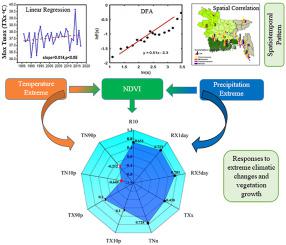Journal of Environmental Management ( IF 8.7 ) Pub Date : 2021-04-02 , DOI: 10.1016/j.jenvman.2021.112505 Abu Reza Md Towfiqul Islam , H.M.Touhidul Islam , Shamsuddin Shahid , Mst Khadiza Khatun , Mir Mohammad Ali , M.Safiur Rahman , Sobhy M. Ibrahim , Alia M. Almoajel

|
Climate extremes have a significant impact on vegetation. However, little is known about vegetation response to climatic extremes in Bangladesh. The association of Normalized Difference Vegetation Index (NDVI) with nine extreme precipitation and temperature indices was evaluated to identify the nexus between vegetation and climatic extremes and their associations in Bangladesh for the period 1986–2017. Moreover, detrended fluctuation analysis (DFA) and Morlet wavelet analysis (MWA) were employed to evaluate the possible future trends and decipher the existing periodic cycles, respectively in the time series of NDVI and climate extremes. Besides, atmospheric variables of ECMWF ERA5 were used to examine the casual circulation mechanism responsible for climatic extremes of Bangladesh. The results revealed that the monthly NDVI is positively associated with extreme rainfall with spatiotemporal heterogeneity. Warm temperature indices showed a significant negative association with NDVI on the seasonal scale, while precipitation and cold temperature extremes showed a positive association with yearly NDVI. The DEA revealed a continuous increase in temperature extreme in the future, while no change in precipitation extremes. NDVI also revealed a significant association with extreme temperature indices with a time lag of one month and with precipitation extreme without time lag. Spatial analysis indicated insensitivity of marshy vegetation type to climate extremes in winter. The study revealed that elevated summer geopotential height, no visible anticyclonic center, reduced high cloud cover, and low solar radiation with higher humidity contributed to climatic extremes in Bangladesh. The nexus between NDVI and climatic extremes established in this study indicated that increasing warm temperature extremes due to global warming might have severe implications on Bangladesh's ecology and the environment in the future.
中文翻译:

植被变化与极端气候指数之间的时空联系及其变化的可能原因
极端气候对植被有重大影响。但是,关于孟加拉国对极端气候的植被反应知之甚少。评价了归一化植被指数(NDVI)与9个极端降水和温度指数之间的联系,以识别1986-2017年期间孟加拉国植被与气候极端之间的联系及其联系。此外,分别在NDVI和极端气候的时间序列中,分别使用了去趋势波动分析(DFA)和Morlet小波分析(MWA)来评估可能的未来趋势并破译现有的周期性周期。此外,使用ECMWF ERA5的大气变量来检验造成孟加拉国极端气候的偶然循环机制。结果表明,每月NDVI与极端降雨和时空异质性呈正相关。在季节尺度上,温暖的温度指数与NDVI呈显着负相关,而降水量和寒冷的极端温度与年度NDVI呈正相关。DEA揭示了未来极端温度的持续升高,而极端降水没有变化。NDVI还显示与极端温度指数显着相关,该温度指数具有一个月的时间滞后,并且与极端降水而无时间滞后。空间分析表明,沼泽植被类型在冬季对极端气候不敏感。研究表明,夏季地势高度升高,没有可见的反气旋中心,减少了高云量,较低的太阳辐射和较高的湿度造成了孟加拉国的极端气候。这项研究确定的NDVI与极端气候之间的联系表明,由于全球变暖导致极端温暖的极端气温可能对孟加拉国的未来生态和环境产生严重影响。


























 京公网安备 11010802027423号
京公网安备 11010802027423号